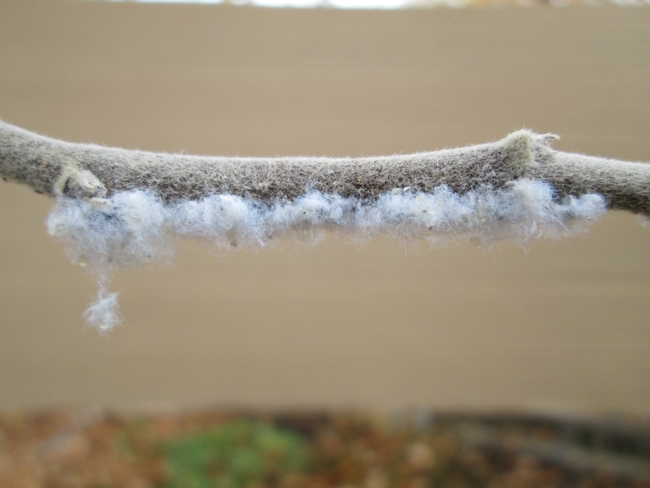Each fall my Gravenstein apple gets a small patch of fluffy exudate on the bark at the base of the tree. These are caused by woolly apple aphids, Eriosoma lanigerum. I hose them off with a jet of water which is usually the end of the problem. However, this year the tree is much more severely affected which has encouraged me to look into this pest more deeply.
This aphid infects apple trees not only above ground but also underground where they can cause distortion of the roots which become small fibrous masses with the formation of galls and knots. The underground damage which is caused by overwintering nymphs is often more severe than the damage caused to twigs and branches. On the exposed parts of the tree it is often suckers, watersprouts, pruning cuts or wounds that get attacked first. This year, on my tree most of the individual leaf nodes are affected.
Alternate hosts for this aphid are elm trees, and unfortunately these are ubiquitous in many parts of the Owens Valley. Eggs are laid in cracks in the bark in the fall, and these hatch in spring. After a couple of generations living on these trees, in the summer a generation develops wings and migrate to apple trees (or other members of that family – hawthorn, pear or mountain ash) where several more generations are produced. In areas where elms no longer grow the aphid will live on apple trees year round.
Although natural enemies such as syrphid flies and parasitic wasps feed on the above-ground woolly apple aphid these appear to be scarce to nonexistent in November in the Owens Valley, and the aphids are proliferating at an alarming rate. While one does not want to use pesticides which will potentially harm beneficial insects I am considering trying neem oil to achieve some sort of control. There appear to be no methods of controlling the underground nymphs.
Several rootstocks used in the grafting of apple trees are resistant to woolly apple aphid. One of these is M.111 and the Merton series of Malling rootstocks. Interestingly, in my own garden, while the Gravenstein apple is severely affected the Golden Delicious tree right next to it has no evidence of this pest. Although rootstock varieties have been lost in the mists of time I can only assume that this is what has caused the difference. There are differences in susceptibility of different cultivars, so perhaps Golden Delicious is more resistant.
With our climate becoming hotter, our trees, already under considerable stress, will be facing greater challenges so perhaps it is time to pay more attention to such factors as the rootstock used when buying fruit trees for the home garden.
For more detailed information on woolly apple aphids, see one of the links below.
